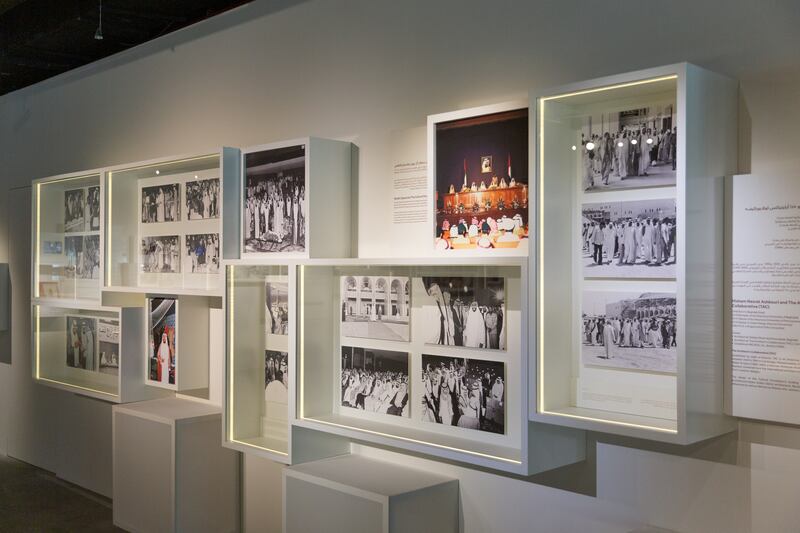Today, the Cultural Foundation in Abu Dhabi is most recognised as a community centre for art and learning, but a new exhibition at the venue showcases its beginnings as a national library and research hub, hosting disparate social, cultural and even diplomatic functions.
Running until February 15, Al Mujamma tells the story of the Cultural Foundation through interactive archival footage and materials. The exhibition marks important moments, including the foundation’s history, from its conceptualisation by Sheikh Zayed, the Founding Father, and its establishment in 1973, to its official opening in 1981, closure in 2010 and then reopening in 2018, after extensive conservation and remodelling work.
“The intention of the exhibition is not to present a historical timeline of the Cultural Foundation,” says Aysha Al Hemeiri, who is part of the curatorial team behind Al Mujamma. “It is rather to showcase the interaction of the Cultural Foundation with the public. It also sheds light on how it was formed from a political sense, showing it had mandates from the government it was fulfilling.”
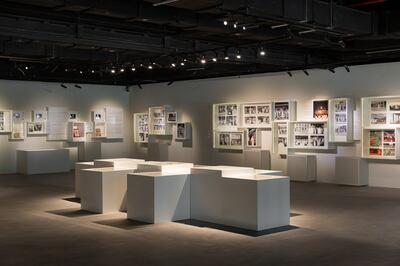
The foundation held a multitude of roles during its formative years, holding everything from book fairs and official meetings to live performances. Its multipurpose nature, Al Hemeiri says, is evident once we consider its former name.
“It was called the Centre for Documentation and Research, National Archive and Institution for Culture and Arts,” Al Hemeiri says. “It held that name since the idea was conceived in 1973. The concept was that it would hold these three divisions and work directly with the important mandates by the government.”
The centre was renamed the Cultural Foundation after its official opening in 1981. The building is regarded as one of the most noteworthy modern heritage developments typifying Postmodern architecture in the UAE.
Al Mujamma: a journey through history
Through archival video and photographs, Al Mujamma exhibition highlights some of the cultural experiences the venue presented in its earliest days, through its National Library, theatre, fine art exhibitions and public events.
The exhibition’s title, Al Hemeiri says, is a nod to the foundation’s current name in Arabic, and represents the communal principles with which it was founded.
“A lot of people think Mujamma means foundation, but the word implies bringing things together,” she says. “It had core mandates that it brought together.”
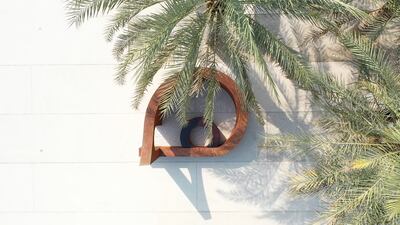
Commissioned installations by three Emirati artists highlight three time periods in the foundation’s history. Seven Birds by Mahmoud Al Ramahi reflects upon the foundation’s role in the 1980s. Made of steel, stones and 3D-printed material, the sculpture represents the seven emirates and the seven days in the week. The birds, the sculpture’s caption reads, represent the foundation’s role in providing “a central place for the community to fly”.
Jalal Luqman derived inspiration from the 1990s era of the foundation, creating the steel installation Cultural Tranquility that alludes to the trees and arches of the old Cultural Foundation.
Azza Al Qubaisi’s installation Ha’a renders the Arabic letter in stainless steel. The artwork, which explores the foundation in the 2000s, is “inspired by the journey of exploring Arabic alphabets through simple lines", the caption reads, “with the aim of building a better connection with the language for the younger generation”.
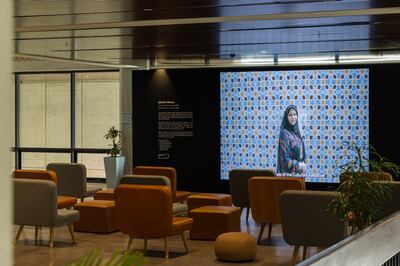
A series of six short films are also being shown as part of Al Mujamma exhibition. They highlight the history of art in the UAE and feature interviews with pioneering UAE artists including Al Ramahi, Obaid Suroor, Mohamed Yousif, Abdul Rahim Salem, Khulood Al Jabri and Mona Al Khaja, all of whom worked closely with the foundation early in their careers.
Experience Mars, an exhibition for children
The foundation has also launched an interactive children’s exhibition that celebrates the Emirates Mars Mission.
Experience Mars, also running until Tuesday, February 15, gives children the chance to venture to space themselves through an interactive experience that leads them to colonising the Red Planet.
Curator of the exhibition Khalid Abu Sharif says the exhibition was founded on the same pedagogical approach as the foundation’s Children’s Library.
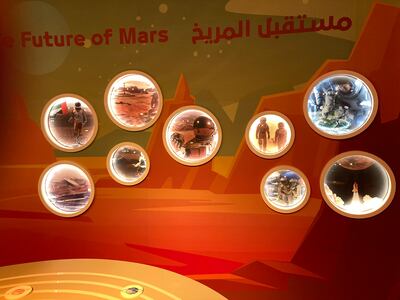
“We believe in a learning from play approach,” he says. “We wanted to create with this exhibition the same kind of philosophy. We wanted to create a space that could educate but also be super fun.”
The exhibition begins in a spaceship cockpit replete with toggles and buttons. As the rocket ascends to space, visitors will be guided into the next room, where touchscreen displays will prompt them to build their own satellites, which they can then see projected as a hologram.
The exhibition’s final hall, a red-lit space alluding to Mars’s surface, is filled with interactive installations that will help visitors set up the first colony on the planet. The space also features a model colony, which was built based on discussions with children who took part in the foundation’s online programme.
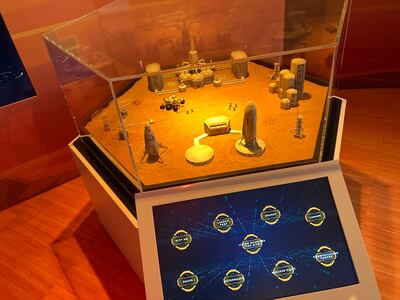
“We talked to them about the design and what it would like,” Abu Sharif says. “But we also did storytelling. We discussed what people would need to live on Mars, how they would get there, who would those astronauts be.”
The model colony being exhibited, Abu Sharif says, is only the first prototype, with others being considered.
Mohammed Chabaa: a retrospective
Finally, the retrospective exhibition Mohammed Chabaa: Visual Consciousness will remain on display until December 19. Having opened earlier this year, the show presents more than five decades of work by the pioneering Moroccan artist, who is also a prominent figure in Global South modernity.
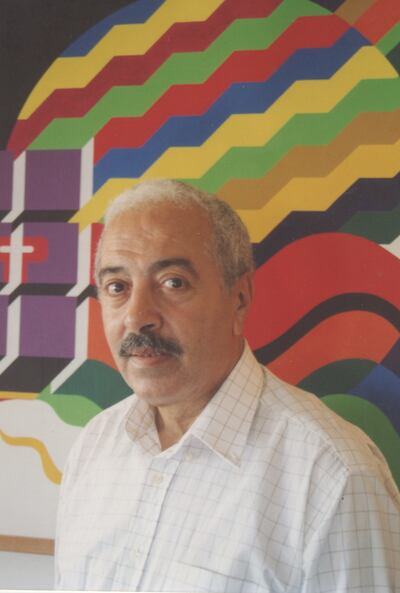
The collection highlights Chabaa’s ceaseless experimentation with Moroccan artisanal craft motifs as well as his subversive stance against established artistic precepts.
Noor Al Mehairbi, who was part of the curatorial team supporting curator Fatima-Zahra Lakrissa, says Chabaa also found inspiration in the Bauhaus movement, post-war abstraction and the avant-garde. He was part of the Casablanca Group with other pioneering Moroccan artists, including Farid Belkahia and Mohamed Melehi. The group pushed forward interdisciplinary ideas of pedagogy and creation, integrating painting, craft, architecture and design.
“We really felt it was important to exhibit Chabaa’s work as one of our first historical shows in the foundation because he played such a huge role in the development of Morocco’s modern visual language,” Al Mehairbi says. “And it really sets a precedent to a lot of growing art movements at the time.”
